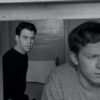In the hundreds of times Jeffrey Karoff has watched his short film about Ra Paulette, a 67-year-old man who developed a passion for carving out caves in New Mexico at the age of 39, he always comes back to the same thing.
“There’s one line in there that always strikes me,” says Karoff of his Oscar-shortlisted documentary “Cavedigger.” “And that is when [Paulette] says, ‘I don’t do anything to get ahead in life. I just keep waiting for something to fall from heaven, and I believe it will.’ I’d think, ‘Yeah, that was me. I have to work so hard to get what I want in life, and all you do is wait for it.’ I think that when the timing was right [for him], somehow he was ready for it.”
The same could be said for Karoff, who found a special subject after spending three years off and on with the unique artist who uses the supple sandstone of the desert to forge cathedral-like caverns. A strong believer in a spartan existence, Paulette lets his extravagant dens exude all that’s meaningful to him. Yet in his pursuit of perfection on each of his large-scale projects, Paulette finds that the cost-conscious patrons don’t hold his artistry to the same exacting standards as he does, often requesting that he leave things be at 85 percent when only 100 percent looks complete to him.
This dance between what the artist wants and what his audience does is captured beautifully in “Cavedigger,” a character study as carefully etched as one of Paulette’s caves. Focusing not only on Paulette but the people who commission his sculptures, the film asks what price is paid by each while chronicling a true iconoclast at work. Recently, Karoff spoke about how he came across the quite literal underground artist, how he discovered what story he really wanted to tell and the ironic position the modest Paulette finds himself in now that the film is being discussed as a potential Oscar nominee.
I met Ra 10 years ago or so. In the town where he lives in northern New Mexico, I have a house. It’s a place where my wife and I go for vacations. The town is really tiny, really intimate and it’s so small that it has a pancake breakfast fundraiser for the volunteer fire department. It’s that kind of small town. We went to that event, and met two people there who said they were having a cave built on their property. We were obviously intrigued by that and they said, “Well, why don’t you come take a look?” That turned out to be Shel and Liz [who appear in the film]. They showed us their cave, and walking into that space was an experience I will never forget.
To make the transition from being in a very rural untouched landscape to finding a door in the mountain, which is your first clue that something is different, then walking in that door and seeing that gorgeous, Gaudiesque space was a feeling that you don’t get often when you’re confronted by art or even architecture. It was breathtaking, in a very literal sense. You can’t help but gasp when you go inside of it, mostly because I think neither of us had ever seen anything like it before.
At that time, [Shel and Liz] had also expressed to us how exasperated they were at how long the construction process was taking, and [Liz] was battling cancer. They ended up staying at hour our in Los Angeles while she was getting treatment, but that was my first exposure to Ra’s cave, and also an exposure to what I discovered later was really where the essence of the story was — the fact that this had been going on for so long and they were at their wit’s end about it.
There’s a great line in the film where Ra confesses, “I don’t have the reputation or status to call the shots,” obviously ill at ease about the balancing his artistic ambition with the responsibility of being commissioned for his work. Was that immediately apparent to you or did that theme develop over time?
You put your finger on the most challenging thing about making this film. I knew that I could make a film in which I could show his [work] in a way that would be appealing. The spaces are so commanding and the art is so beautiful, I figured I can certainly tell a story about a guy who is doing this unusual work. But I wasn’t really that interested in telling that story because then that becomes kind of a puff piece.
I’m a commercial director, so I had shot a spec spot for my reel featuring Ra, which was what started it all off. I did a one-minute piece, and that was all I was going to do. Then about eight months later, he had [a] collapse in his cave, which I learned about through friends, and I felt like, “Okay, I can no longer deny that this story is calling me. I’ve been tapped on the shoulder to do this and I really have to pursue this as a full documentary.”
Going into it, I still was not sure what story I was telling. I knew that the collapse had its own dramatic value, and I knew that that was going to be something. It was on those trips, and I took a couple of them in a row, that I asked him to put me in touch with his former patrons. Then it became clear what the film was going to be about. But even from the point of going into the edit bay, I was not positive I had a movie. I had a very good idea of what the structure might be and what the themes were. Then when I saw the first assembly of it, I said, there’s something here. There are the things that I love best in films, which are the open-ended existential questions that are not answered.
This may be a reach, but did you feel a kinship with Ra? Knowing about your commercial work, I thought possibly in the same way that Ra felt the desire to do something different, you might have as well.
I think we did. Ra is a very respectful man and he respected that I was doing something that was a vision of my own and was determined not to be to me who his patrons were to him. He said to me over and over again, “This is your film. You should do it the way that you see it.” There was a kinship there. We’re also both visually oriented people. Where we’re so different is that I’m such a worldly person, which I don’t mean as in experience, but I’m of the world. I participate. He is so not that person. There is nothing he would rather do than dig. He spends a lot of his time underground, alone. There’s nothing about that that appeals to me. I read a line once for this film, which was “He’s living the dream so you don’t have to.” [laughs]
One of my very favorite things about the film are the bits of personality that come out, both from Ra and the patrons. Since with a short, you may be dictating the length of your piece in a way you might not otherwise, was it a difficult decision to keep some of those small but telling moments in?
As always, there’s quite a lot more footage shot than is included. There was a lot of stuff that didn’t go in, but there’s two important other aspects of the film besides Ra and his caves. One is the people and their personalities, which are pretty unique to that area. There may be other places in the world that have Northern New Mexico characters in them, but it added so much color and for all of my travels in Northern New Mexico, I’m not jaded about how particular the people are at all.
The other thing that was important to me was the landscape because you can’t go to Northern New Mexico and not be taken by it. It’s so grand and so important. A lot of people go there to visit, and they never leave. I think that this town is actually filled with a lot of people who came from other places and they just get sucked in.
Was it difficult to shoot there? It seems like the conditions might be difficult, and especially inside the caves where you have such amazing images where the light falls on certain things just right.
It was not that difficult to shoot. We were very small and we shot very small. Anghel Decca, my cinematographer, came out there four or five times. We would sometimes pick up two people to help us carry stuff and set stuff up, and sometimes it would be just the two of us shooting. There’s almost no lighting. Other than two interviews that have lights on them, everything is done with available light. We shot it with Canon 5Ds, so it was all pretty small scale. The difficult part was sometimes hiking up to the mountains carrying gear. We did one shoot where we brought up a motorized slider and and it was a lot of gear to haul up the mountain and to set up. But Ra’s a really good guy, and as you can tell from the film he’s extremely strong. He would haul up all our gear; carry the equipment up. We have guys that were half his age that couldn’t do what he was doing.
How much time did you actually spend with him?
I probably shot on maybe 12 different occasions, and those were anywhere between four days long to a half a day. I never totaled it up, but it extended over a three-year period.
One of the problems I always had [envisioned] making this movie was thinking the only way to make this movie is to be there on the day that he breaks ground, then the structure of this movie would be the creation of the cave. Over the years, I missed a bunch of cave starts because we just weren’t in touch with each other. I was in LA, he was in New Mexico. We weren’t that close, it just never really happened.
The reality was even after I started it, I wasn’t there that much. I didn’t want to miss some of the progress of the cave, which by the way is really slow. It comes together, and it doesn’t really look like much while it’s coming together. It’s only when he begins the carving that it really starts to look like something. So I left him with a time-lapse rig, and I showed him how to use it, he set up the rig and shot some time-lapse stuff of himself. He was diligent about it. Quite a few of those shots ended up in the film and filled out the development story of the cave.
What’s it been like to take this film around the world?
It’s really been enjoyable and it’s just been a joy to be able to talk about it. I did some screenings in Santa Fe in which Ra was there, and that was a unique situation, because I knew going into that that I might as well not be there because I have the man himself in his home territory. Quite a lot of the people have actually been in a cave of his at one time or another, and we would do our little Q&A at the end, then afterwards people would just swarm around him like he was Mick Jagger. It was fantastic to see. He was very good for a guy that spends his time underground, pretty much alone.
Do you actually think he likes the attention since as you say he appears to prefer to spend his time alone?
I love that dichotomy in his personality. Because on the one hand, I think he has eschewed attention for most of his life. Certainly, even after almost 30 years of cave-digging, he hasn’t really reached out to the wider public to show his goods the way that you would expect an artist working for that period of time and at that scale. But he would repeatedly tell me recognition was not important. He had had so many individuals come up to him and say, “Your art has changed my life” and he said, “In that way, I have gotten more important recognition than many artists who are famous, and I don’t need any more than that.” But there [seemed to be] something that was ready to be ignited in him about being recognized. Now, that it’s happening, I think he’s liking it a lot.
“Cavedigger” does not yet have distribution.





